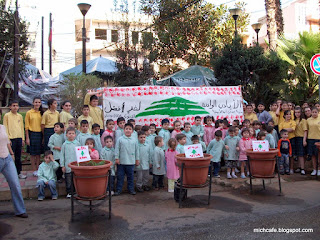Whenever I visit Lebanon, I always reserve a day to visit Beirut’s Armenian suburb, Bourj Hammoud. It always turns into an exciting day of endless walking. And I have no one better to escort me there than my friend Zepure Hamparian Mansour.
Zepure, my sister Asma and I set off from Hamra at around 10 a.m. and tried to catch a share taxi (known as serveess) for the journey to Bourj Hammoud. The neighborhood is just off the Autostrade (highway) and is surrounded by the Dora, Quarantina, Sin el-Fil and Ashrafieh districts. For LL 10,000 ($6.67), we had the share taxi to us.
As soon as the driver saw me pull out my little digital camera , he went to explain all the areas we were passing through. He even stopped traffic on the bridge to Bourj Hammoud so I could take pictures of the signpost at the entrance of the northeastern suburb that covers an area of about one square mile.
Bourj Hammoud is colorful and vibrant and a shopping magnet to boot. A center for crafts and ateliers, it is renowned for its artisanship and jewelry, leather, garments, shoes and mechanical handiworks... It is also the place par excellence for savoring Armenian cuisine.
It is said that this industrious area, where most survivors of the 1915 Armenian Genocide settled, is one of the most densely populated spots in the Middle East. The Armenians who arrived in Beirut in the early 1900s were given the right to put up shacks in what was then a swamp. They were then allowed to erect buildings and houses.
Bourj Hammoud became an independent municipality in 1952 and is now member of the Metn-North group of local authorities.
 |
| Many of the houses have wooden balconies |
To catch this dynamism, you might wish to walk around with us by looking at the pictures (here) while listening to tunes created by famous Armenian musician and composer Djivan Gasparyan (here). He is the master of the duduk, the traditional double reed woodwind instrument, traditionally made from apricot wood.
 |
| The pupils from Karasoun Manoug in Municipality Square |
 |
| Hovig preparing our tahin hatz |
 |
| Other items on sale at Geka |
 |
| With Mher Krikorian |
Visiting our friend Ani Bodroumian, the owner of Yerevan stores was next. All Ani’s goods are imported from Armenia and it is always interesting to hear her explain the origin, history and mythology of the various items.
 |
| Pomegranates in all shapes and sizes at Yerevan |
I observed items made of a black stone with the wonder of a child. Ani said it was obsidian, a semi-precious stone largely found in Armenia, a country rich in high-grade and semi-precious and precious stones. Among them: obsidian, amethyst, andesine, andelusite, emerald, garnet, beryl, turquoise, several grades of quartz, carnelian, aquamarine, lapis lazuli and diamonds.
 |
| Katchkars carved in wood and obsidian |
A few days later, I read that the United Nations Educational, Scientific and Cultural Organization (UNESCO) declared the Armenian Katchkar (cross stone) an intangible cultural heritage in need of urgent safeguarding. Armenia’s application traces the history of the Katchkar and its spiritual role, detailing its roots and development through the centuries and into modern times. The report, titled “Armenian Cross-Stones Art: Symbolism and Craftsmanship of Katchkars,” can be found on the UNESCO website here.
 |
| The Armenian alphabet or Mesrob-Mashtotz |
Mesrob determined that 36 characters were needed and decided to write the characters from left to right as in Greek. According to tradition, while meditating in a cave near the village of Palu, the saint had a vision in which “the hand of God wrote the alphabet in letters of fire.” The original set of characters is still used today.
Other imported items at Yerevan are the different spirits produced in Armenia, like Cognac, wine and vodka. The famous Mane Cognac, from the Prochian region, is produced in a joint venture with the French who are training locals over 10 years. The wine also comes from Prochian. Ani Bodroumian says there are 38 types of grape and fruit wines, including pomegranate, plum, apricot and apple. Armenian vodka also comes in different tastes from traditional to fruity with lemon, apricot, pomegranate and the most famous, blueberry vodka.
 |
| Shawarma and basterma at Bedo |
 |
| Asma and Zepure with Nercess |
 |
| Apo preparing the kefta sandwiches |
Five hours later, we were on our way back home. Our backs and legs were sore the next day, but it was worth it.

